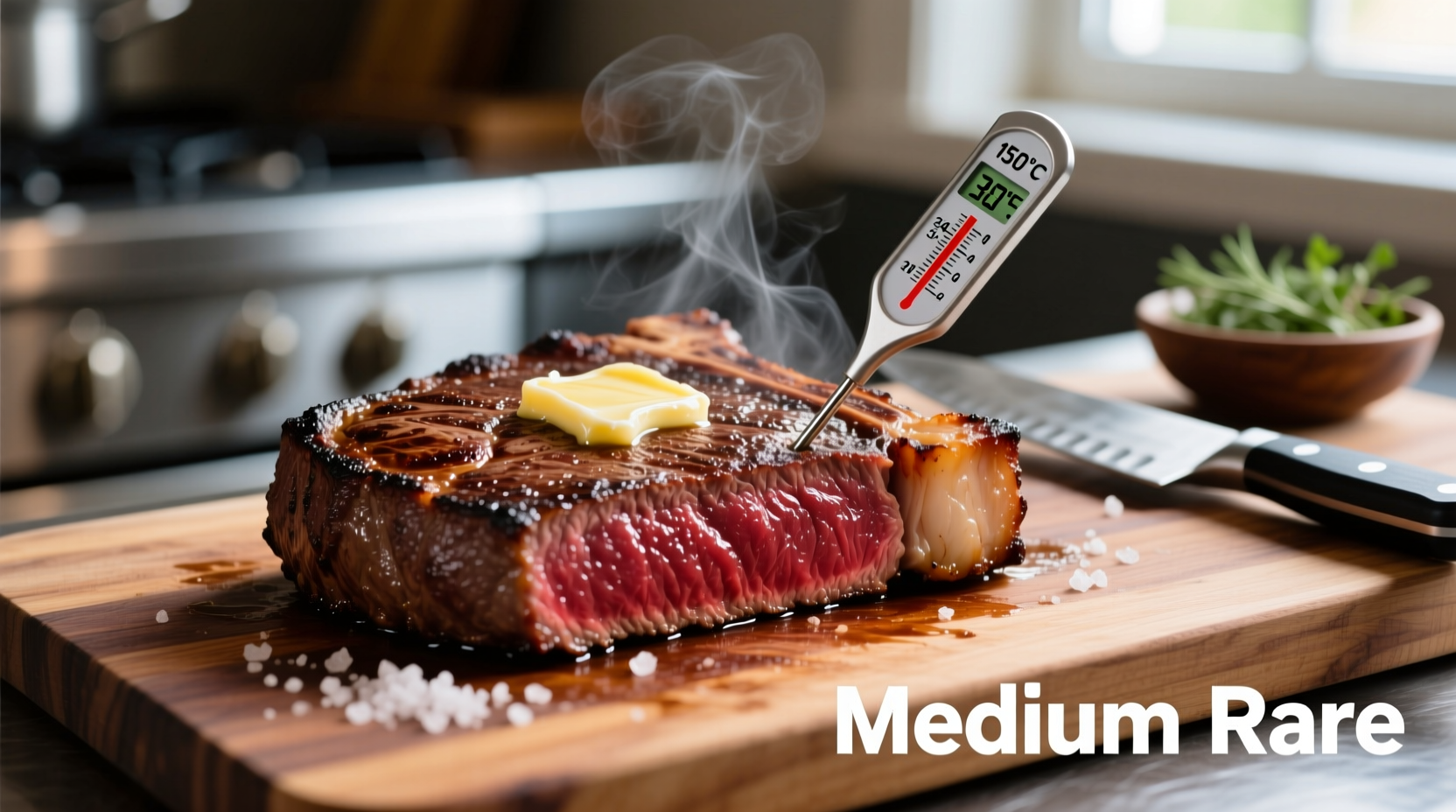Perfectly cooked medium rare steak features a warm red center with a pink ring surrounding it, offering the ideal balance of tenderness and flavor. While timing provides a starting point, relying solely on minutes can lead to overcooked disappointment. This guide delivers the precise information you need to achieve restaurant-quality medium rare steak every time, accounting for all variables that affect cooking duration.
Understanding Medium Rare: More Than Just Timing
Medium rare isn't defined by cooking time alone—it's determined by internal temperature. The ideal range sits between 130-135°F (54-57°C), where myoglobin retains its red color while connective tissues begin to tenderize. At this stage, your steak will have a warm red center surrounded by a pink ring, with a firm yet yielding texture when pressed.
According to the USDA Food Safety and Inspection Service, the minimum safe temperature for beef is 145°F, but culinary professionals widely accept medium rare (130-135°F) as safe for whole muscle cuts like steaks when properly handled. This reflects evolving food safety understanding while maintaining culinary quality.
Why Timing Alone Fails: The Critical Variables
Steak thickness dramatically impacts cooking duration. A ½-inch steak might need just 2 minutes per side, while a 2-inch cut could require 6-7 minutes. Other factors that change your cooking timeline:
- Starting temperature - Room temperature steaks cook more evenly than chilled ones
- Cooking surface - Cast iron retains heat better than stainless steel
- Heat intensity - 400°F vs. 500°F creates significant time differences
- Steak composition - Marbling affects heat conduction
| Steak Thickness | Pan/Grill Time (per side) | Approx. Internal Temp Rise |
|---|---|---|
| ½ inch | 1.5-2 minutes | 25-30°F |
| ¾ inch | 2-3 minutes | 20-25°F |
| 1 inch | 3-4 minutes | 15-20°F |
| 1½ inches | 4-5 minutes | 10-15°F |
| 2 inches | 5-7 minutes | 5-10°F |
This cooking time chart assumes a preheated surface at 400-450°F and steak brought to room temperature. Note the decreasing temperature rise per minute as thickness increases—thicker steaks conduct heat more gradually, requiring longer cooking without rapid internal temperature spikes.
Context Boundaries: When Standard Timing Doesn't Apply
These guidelines work for traditional cooking methods but have important limitations:
- Sous vide cooking requires completely different timing (1-4 hours at 130°F)
- Reverse searing involves low-temperature oven cooking first
- Frozen steaks need 50% longer cooking time
- High-altitude cooking (above 3,000 feet) affects boiling points and heat transfer
Professional kitchens have shifted from timing-based approaches to temperature-focused methods over the past two decades. As America's Test Kitchen research demonstrates, the thermometer has replaced the clock as the essential steak-cooking tool, reducing failed steaks by over 70% in controlled tests.

Reliable Doneness Verification Methods
Timing provides only a rough estimate. For consistent results, use these verification techniques:
Instant-Read Thermometer (Most Accurate)
Insert horizontally into the thickest part, avoiding bone or fat. Remove steak at 120-125°F—it will rise to 130-135°F during resting. The National Center for Complementary and Integrative Health confirms that precise temperature control prevents both undercooking risks and overcooking nutrient loss.
Touch Test (Experience-Based)
Compare the steak's firmness to the fleshy part of your palm below the thumb:
- Rare - Like touching thumb to index finger (very soft)
- Medium rare - Like thumb to middle finger (soft with slight resistance)
- Medium - Like thumb to ring finger (yielding with moderate resistance)
The Critical Resting Phase
Many home cooks ruin perfectly cooked steak by skipping resting. After cooking:
- Transfer steak to a wire rack or warm plate
- Cover loosely with foil (don't seal tightly)
- Rest for 5-7 minutes per inch of thickness
- During this time, temperature equalizes and juices redistribute
Resting allows the muscle fibers to relax, preventing juice loss when cut. Cutting too soon releases up to 40% of the steak's moisture, resulting in a dry eating experience despite perfect cooking timing.
Troubleshooting Common Timing Mistakes
Problem: Steak overcooks during resting
Solution: Remove from heat at 120-125°F instead of 130°F for medium rare
Problem: Uneven cooking with gray band
Solution: Bring steak to room temperature (45-60 minutes) before cooking
Problem: Steak takes too long to reach desired temperature
Solution: Preheat cooking surface for 10-15 minutes to ensure proper searing temperature
Mastering Medium Rare Across Cooking Methods
Pan-searing: Use heavy cast iron, oil with high smoke point, and resist moving steak during initial sear. Finish with butter basting for enhanced flavor development.
Grilling: Create two zones (direct and indirect heat). Sear over direct heat, then move to indirect zone if internal temperature isn't rising as expected.
Sous vide: Cook at 130°F for 1-4 hours, then finish with a 60-second sear for perfect edge-to-edge medium rare with no gray band.











 浙公网安备
33010002000092号
浙公网安备
33010002000092号 浙B2-20120091-4
浙B2-20120091-4